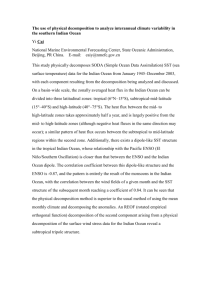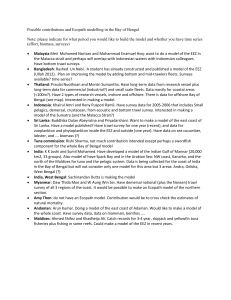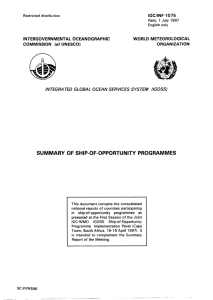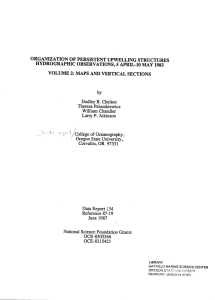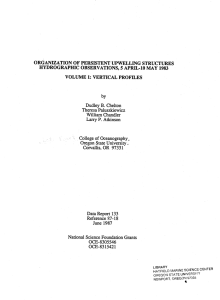Long-term temperature trends in the Bay of Bengal
advertisement
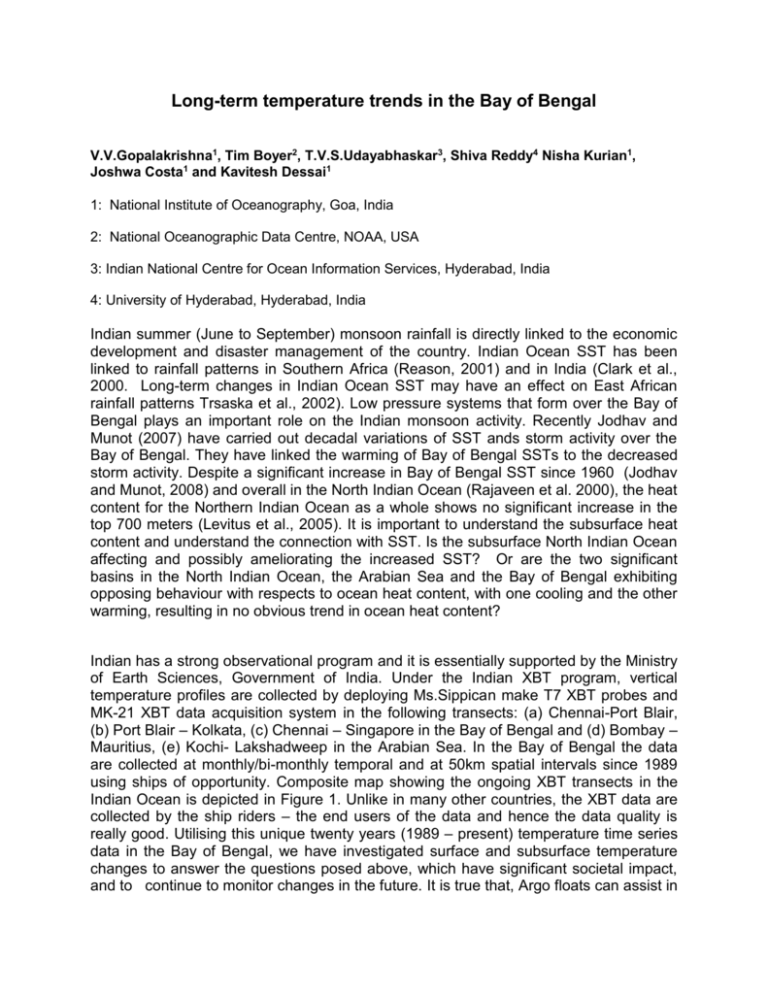
Long-term temperature trends in the Bay of Bengal V.V.Gopalakrishna1, Tim Boyer2, T.V.S.Udayabhaskar3, Shiva Reddy4 Nisha Kurian1, Joshwa Costa1 and Kavitesh Dessai1 1: National Institute of Oceanography, Goa, India 2: National Oceanographic Data Centre, NOAA, USA 3: Indian National Centre for Ocean Information Services, Hyderabad, India 4: University of Hyderabad, Hyderabad, India Indian summer (June to September) monsoon rainfall is directly linked to the economic development and disaster management of the country. Indian Ocean SST has been linked to rainfall patterns in Southern Africa (Reason, 2001) and in India (Clark et al., 2000. Long-term changes in Indian Ocean SST may have an effect on East African rainfall patterns Trsaska et al., 2002). Low pressure systems that form over the Bay of Bengal plays an important role on the Indian monsoon activity. Recently Jodhav and Munot (2007) have carried out decadal variations of SST ands storm activity over the Bay of Bengal. They have linked the warming of Bay of Bengal SSTs to the decreased storm activity. Despite a significant increase in Bay of Bengal SST since 1960 (Jodhav and Munot, 2008) and overall in the North Indian Ocean (Rajaveen et al. 2000), the heat content for the Northern Indian Ocean as a whole shows no significant increase in the top 700 meters (Levitus et al., 2005). It is important to understand the subsurface heat content and understand the connection with SST. Is the subsurface North Indian Ocean affecting and possibly ameliorating the increased SST? Or are the two significant basins in the North Indian Ocean, the Arabian Sea and the Bay of Bengal exhibiting opposing behaviour with respects to ocean heat content, with one cooling and the other warming, resulting in no obvious trend in ocean heat content? Indian has a strong observational program and it is essentially supported by the Ministry of Earth Sciences, Government of India. Under the Indian XBT program, vertical temperature profiles are collected by deploying Ms.Sippican make T7 XBT probes and MK-21 XBT data acquisition system in the following transects: (a) Chennai-Port Blair, (b) Port Blair – Kolkata, (c) Chennai – Singapore in the Bay of Bengal and (d) Bombay – Mauritius, (e) Kochi- Lakshadweep in the Arabian Sea. In the Bay of Bengal the data are collected at monthly/bi-monthly temporal and at 50km spatial intervals since 1989 using ships of opportunity. Composite map showing the ongoing XBT transects in the Indian Ocean is depicted in Figure 1. Unlike in many other countries, the XBT data are collected by the ship riders – the end users of the data and hence the data quality is really good. Utilising this unique twenty years (1989 – present) temperature time series data in the Bay of Bengal, we have investigated surface and subsurface temperature changes to answer the questions posed above, which have significant societal impact, and to continue to monitor changes in the future. It is true that, Argo floats can assist in this monitoring, but add the complication of a completely different monitoring system with irregular sampling in the area along the time series XBT lines. Further, number of ARGO floats available in the Bay of Bengal particularly in the northern bay are far minimal compared to the Arabian Sea and other regions of the Indian Ocean. Often, the floats in the northern bay does not pop-up to the near surface layers to transmit the data due to strong stratification caused due to the continuous discharge of abundant fresh waters through perennial rivers located along the east coast of India and also due to the precipitation over the bay. The consistent 20 year monitoring provided by the XBT lines should continue into the future. Some results of preliminary work looking at long term change in the Bay of Bengal are presented. The XBT time series provided by the National Institute of Oceanography, Goa - India shown in the red box in Figure 2a were binned by year after statistical removal of the XBT bias and subtraction of the climatological monthly mean temperature as per Levitus et al. (submitted). Figure 2b shows temperature anomaly at the sea surface (black), and temperature anomaly at 600 meters depth (red). Both exhibit a trend of increasing temperature. Figure 2c shows the temperature anomaly at the surface (black) again along with temperature anomaly at 100 meters depth. The temperature anomaly at 100 meters depth exhibits strong year to year variability (note the larger intervals on the temperature axis) and no long term trend. This is near the depth of the thermocline in this area. It may be that, while the surface and 600 meters show significantly increasing temperatures, depths in between do not exhibit the increase, and are at times, opposite in sign to the upper and lower depths. This type of study, which is preliminary, can only be performed using the long-time series provided by the XBT lines in the Bay of Bengal. Maintaining the lines will extend this work into the future and provide crucial information on climate change in the North Indian Ocean. In fact, National Institute of Oceanography, Goa has started collecting temperature / salinity data regularly along their XBT transects by deploying XCTDs. Fig 1: Composite map showing the ongoing XBT transects executed by the National Institute of Oceanography, Goa, India. Fig 2


